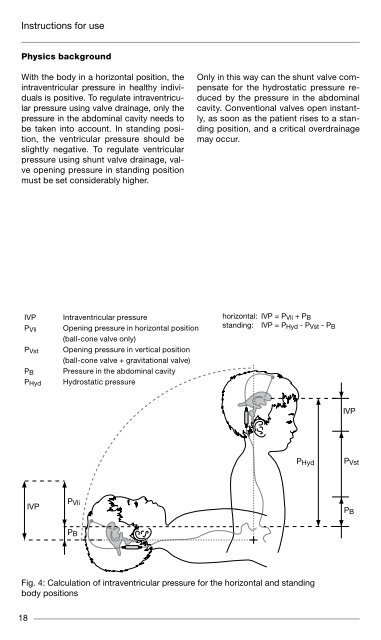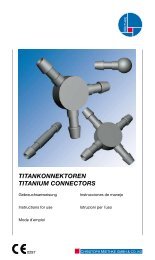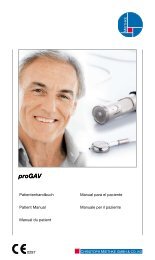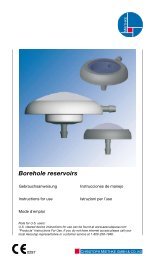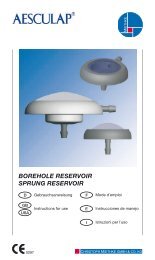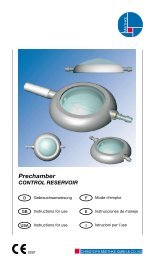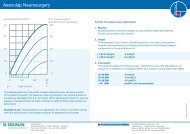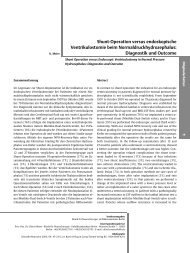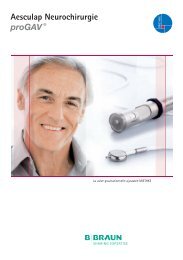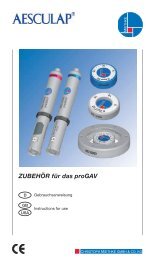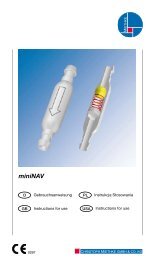paediGAV - Christoph Miethke GmbH & Co. KG
paediGAV - Christoph Miethke GmbH & Co. KG
paediGAV - Christoph Miethke GmbH & Co. KG
You also want an ePaper? Increase the reach of your titles
YUMPU automatically turns print PDFs into web optimized ePapers that Google loves.
Instructions for use<br />
Physics background<br />
With the body in a horizontal position, the<br />
intraventricular pressure in healthy individuals<br />
is positive. To regulate intraventricular<br />
pressure using valve drainage, only the<br />
pressure in the abdominal cavity needs to<br />
be taken into account. In standing position,<br />
the ventricular pressure should be<br />
slightly negative. To regulate ventricular<br />
pressure using shunt valve drainage, valve<br />
opening pressure in standing position<br />
must be set considerably higher.<br />
IVP Intraventricular pressure<br />
PVli Opening pressure in horizontal position<br />
(ball-cone valve only)<br />
PVst Opening pressure in vertical position<br />
(ball-cone valve + gravitational valve)<br />
PB Pressure in the abdominal cavity<br />
PHyd Hydrostatic pressure<br />
18<br />
IVP<br />
PVli<br />
PB<br />
Only in this way can the shunt valve compensate<br />
for the hydrostatic pressure reduced<br />
by the pressure in the abdominal<br />
cavity. <strong>Co</strong>nventional valves open instantly,<br />
as soon as the patient rises to a standing<br />
position, and a critical overdrainage<br />
may occur.<br />
horizontal: IVP = PVli + PB<br />
standing: IVP = PHyd - PVst - PB<br />
PHyd<br />
Fig. 4: Calculation of intraventricular pressure for the horizontal and standing<br />
body positions<br />
IVP<br />
PVst<br />
PB<br />
Selecting the appropriate <strong>paediGAV</strong><br />
The <strong>paediGAV</strong> is a site-dependent valve. It<br />
features two different opening pressures,<br />
one is suitable for the patient‘s horizontal<br />
body position, while the other is used<br />
for the vertical position. This obviates the<br />
necessity of performing percutaneous<br />
modification of valve opening pressure<br />
as much as increased opening pressure<br />
in vertical body position counteracts an<br />
unfavorably high level of drainage. In horizontal<br />
position, on the other hand, the<br />
requisite low opening pressure prevents<br />
underdrainage.<br />
Instructions for use<br />
Horizontal body position:<br />
For the horizontal position, two different<br />
opening pressure settings are available<br />
(4 and 9 cmH2O). Selection of the appropriate<br />
pressure rating should be made in<br />
accordance with indication (age of the<br />
patient).<br />
Vertical body position:<br />
The opening pressure for the vertical<br />
body position depends upon the size of<br />
the patient (hydrostatic parameter). If an<br />
infant is being treated, a low pressure rating<br />
should be selected. If, on the other<br />
hand, a larger child is being treated, a<br />
<strong>paediGAV</strong> with a higher pressure rating<br />
should be applied.<br />
Every <strong>paediGAV</strong> is calibrated according to strict quality control standards. The following<br />
pressure combinations are available:<br />
Opening pressure<br />
(cmH2O)<br />
horizontal vertical<br />
<strong>Co</strong>ding in<br />
X-Ray Image<br />
Standard pressure level<br />
Recommendation<br />
4 24 children up to 6 months<br />
9 24<br />
Children from 6 months<br />
to 5 years<br />
9 29 children over 5 years<br />
4 14<br />
4 19<br />
9 19<br />
Special pressure level<br />
Fig. 5 recommendation of pressure levels (see www.miethke.com)<br />
Radiograph of<br />
a <strong>paediGAV</strong><br />
(9/24 cmH2O)<br />
19


